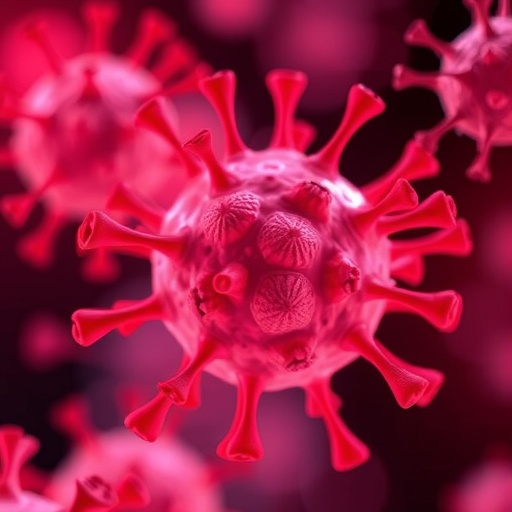Recent investigations into the biochemical intricacies of cellular processes have illuminated a novel realm of protein modifications known as the “lactylome.” In a groundbreaking study published in the Journal of Ovarian Research, a research team led by scholars including Fan, Zhou, and Wen delves deep into the lactylation of proteins in porcine granulosa cells, a type of cell found in the ovarian follicle that plays a crucial role in reproductive physiology. This meticulous examination unveils a sophisticated layer of regulation mediated by lactylation that could significantly impact our understanding of cellular functionality and fertility.
Lactylation represents a unique post-translational modification, wherein lactate, a metabolic byproduct, is covalently attached to lysine residues on proteins. Unlike more established modifications such as phosphorylation and acetylation, the field of lactylation is relatively nascent, albeit rapidly evolving. The research focuses on the role of this modification in granulosa cells, which are integral for the maturation of oocytes and hormone production. This study contrasts with traditional approaches by offering insight into metabolic shifts and how these influence protein functions.
One pivotal aspect of this research involves the global profiling of the lactylome, revealing not just the presence of lactylated proteins but also their potential functional implications. The study employs advanced mass spectrometry techniques that allow for comprehensive identification and quantification of lactylated lysines across a wide spectrum of proteins. This technological integration signifies a notable advancement in the field of proteomics, enhancing our ability to track and analyze post-translational modifications at an unprecedented scale.
The findings suggest that lactylation may facilitate diverse cellular processes, including those related to energy metabolism, gene expression, and stress responses. By mapping out the lactylome within porcine granulosa cells, the researchers provide evidence that lactate does not merely serve as a metabolic waste product but rather plays an active role in modulating protein functions. This interplay between metabolism and protein modification underscores the dynamic nature of cellular environments, wherein nutrients can directly influence cellular phenotypes.
Additionally, the implications of these discoveries transcend mere academic curiosity; they hold significant promise for advancing reproductive biology and veterinary medicine. The health of the ovarian reserve, reflected in the functionality of granulosa cells, is crucial for fertility outcomes. Insights gleaned from the lactylome can inform therapeutic strategies for addressing fertility issues, enabling targeted interventions aimed at restoring or enhancing ovarian function.
Moreover, the broader implications of this research touch upon the importance of metabolic health, linking lactate dynamics to various physiological and pathological states. While the study specifically examines porcine granulosa cells, the evolutionary conservation of lactylation across species suggests that these findings may extend to human reproductive health as well. The interconnections between metabolic status and reproductive capacity illustrate the necessity for a holistic approach to fertility treatments and interventions.
As the scientific community continues to unravel the complexities of protein modifications, the field of lactylation is likely to expand, ushering in new paradigms in molecular biology and biochemistry. The identification of lactylation as a significant post-translational modification highlights the need for further research to elucidate its mechanisms and downstream effects on cellular functions. Future studies may well investigate the role of lactylation in various cell types and conditions, potentially spawning a new wave of discovery in the realms of metabolism, development, and disease.
The long-term goal remains clear: understanding the lactylome not only enhances our appreciation of cellular processes but also sets the stage for novel therapeutic avenues. As researchers leverage cutting-edge technologies and innovative methodologies, the quest to decipher the cellular language of protein modifications like lactylation is likely to yield insights that reverberate across multiple disciplines. The potential to harness these findings for clinical applications makes the allure of continued exploration all the more compelling.
In summary, the investigation into the lactylation of proteins within porcine granulosa cells signifies a pioneering step forward in our comprehension of protein modifications and their implications for reproductive health. As scientists like Fan, Zhou, and Wen contribute to this burgeoning field, the interplay between metabolism and cellular regulation continues to receive heightened attention. With continued research and exploration into the lactylome, the future promises exciting revelations that may reshape our understanding of fertility and cellular function.
The study not only highlights the biochemical significance of lactylation but also positions it within a broader context of metabolic influence on reproductive physiology, urging researchers to reconsider traditional views on nutrient functions. The role of lactate in cellular signaling pathways is poised to become a focal point for further investigations, and one can only anticipate the transformative impact this will have on both basic and applied science in the near future.
The emerging narrative around the lactylome and its potential applications illustrates the interconnectedness of metabolic pathways, protein chemistry, and reproductive science. At the intersection of these disciplines lies an invaluable opportunity to address pressing challenges in fertility management and metabolic disorders, opening doors to novel therapeutic strategies grounded in our growing understanding of lactylation.
Subject of Research: Global profiling of protein lactylome in porcine granulosa cells.
Article Title: Global profiling of protein lactylome in porcine granulosa cells.
Article References:
Fan, S., Zhou, R., Wen, H. et al. Global profiling of protein lactylome in porcine granulosa cells.
J Ovarian Res 18, 177 (2025). https://doi.org/10.1186/s13048-025-01762-8
Image Credits: AI Generated
DOI: 10.1186/s13048-025-01762-8
Keywords: Lactylome, protein lactylation, granulosa cells, reproductive health, porcine, mass spectrometry, post-translational modification, fertility.
Tags: advancements in ovarian researchBiochemical pathways in reproductive healthglobal profiling of lactylated proteinsimplications of lactylation on fertilitylactate’s impact on cellular functionslactylome in porcine granulosa cellsmetabolic regulation in ovarian folliclesnovel protein modifications in researchpost-translational modifications in cell biologyprotein lactylation and reproductive physiologyrole of granulosa cells in oocyte maturationunderstanding cellular metabolic shifts





